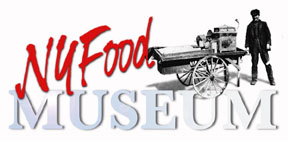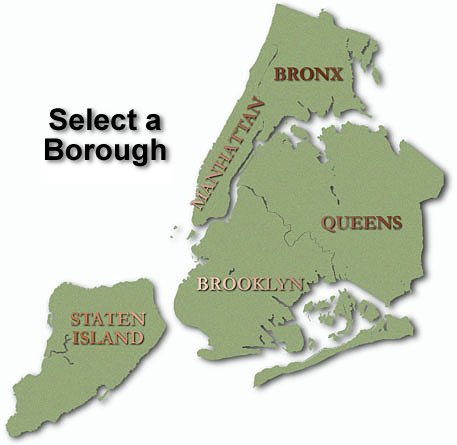WELCOME
to the PERMANENT COLLECTION |
 |
How
New York Ate 100 Years Ago |
||||
|
Click
on the map below for information on each borough |
||||||
|
||||||
In the urban neighborhoods of all boroughs, residents bought bread, milk, ice, fish, hot corn, pie and more from horse-drawn wagons and pushcarts. Children bought snowballs of shaved ice and sweet syrups for a penny. |
||||||
As for restaurants and hotels, they fed millions, from single five-cent meals to $10,000 banquets. Ethnic foods helped establish immigrant enclaves, and dishes and markets were starting to find cross-cultural acceptance. As the largest port and market in North America and a leading manufacturing area, New York City provided food and food products for the entire country. |
||||||
| The variety of ethnic communities and the diversity of immigration to New York created a wealth of cultural traditions, each community taking on a different character as it grew, strengthened, diversified, assimilated, dispersed, specialized in industry or faced special discrimination. |
||||||
When communities were substantial, their food dynamics affected food quality and prices (for more on the Kosher Meat Riots, click Manhattan on the map above) stimulated import trade, created manufacturing and farming opportunities as in the Chinese farms and restaurants, restaurant chic and frequently food industries, needing limited English language skills or American certifications (see pushcarts for one example, current restaurant practice for another--links from Retail section at left). |
||||||
Opportunities in the food business led to advancement in other food-related businesses, and fostered restaurant ownership and ethnic food manufacture. For recent immigrants, a neighborhood that practiced familiar food traditions meant a place of security, fellow countrymen and women, news from home. |
||||||
Immigrant
communities, particularly Greeks, worked truck farms near Bull's Head
that provided the Manhattan markets with vegetables and livestock for
Washington Market. |
||||||
Thanks
to: Brian Rock - exhibit production and content Annie Hauck-Lawson - inspiration, research and technical advisement Suzanne Wasserman - content advisement Gina Pollara - research and images Mimi Martin - writing and research on Chinatown Yale University Press for permissions on chicle, sugar manufacture and kosher food Peter Pancucci of Flux Co. for Angermeier's and Lüchow's menus Thanks also to Lynn Loflin of the Miracle Grill and Miracle Bar and Grill in Manhattan for providing food for the exhibit opening and emotional support for the duration. |
||||||
 |
||||||
follow
the links under "How New York ate..." at left to continue
your tour |
||||||
